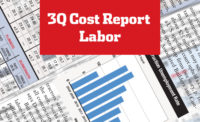While workforce shortages remain a high-risk factor for many contractors, few employers are using significant compensation increases to help address labor needs. For the second year in a row, 80% of firms report they are having a hard time filling hourly craft positions, according to an annual survey of more than 2,500 firms by Autodesk and the Associated General Contractors of America.
About 73% of respondents reported in the August survey that they will have a hard time, and it will get even harder, to find hourly craftworkers during the next 12 months. Stephen Sandherr, AGC’s CEO, said that “workforce shortages remain one of the single most significant threats to the construction industry.”
Increasing compensation is part of the solution for some employers. Two-thirds of firms surveyed report they have increased base pay rates for craftworkers, while 29% are providing incentives and bonuses to attract craftworkers.
Some trades are in higher demand than others. Seven in ten respondents to the AGC/Autodesk survey said that, compared to last year, it is more difficult in 2019 to fill positions for merit shop cement masons, concrete workers, pipelayers, plumbers, carpenters and iron workers. In the union sector, six in ten survey respondents said it was more difficult this year to find concrete workers, bricklayers and pipelayers.
Some union trades are faring better than others in bargaining settlement negotiations. Glaziers, painters, teamsters and carpenters all saw average first-year settlements of 3% or higher in the first half of 2019, according to CLRC data. Boilermakers were the lowest at 2%.
Unions in some regions of the country are also garnering higher increases. The West Coast states saw first-year settlement increases of 3.4% on average in the first half of 2019. The mid-Atlantic and South Central regions of the country saw the lowest increases at 2.3%.
|
Related Link |
Slow Progression
Still, there are limits to what many contractors are willing to offer. Among unions and their employers, wage and benefit settlements have remained remarkably stable in recent years.
Between 2012 and 2018, average first-year increases in settlements grew gradually from 2% to 3%, according to data from the Construction Labor Research Council. In the first half of 2019, first-year increases have averaged 2.8%, the first drop in that average in a decade, says the CLRC data. At that level, first-year increases remain well below the 4% annual bumps seen in the run-up to the 2008 recession.
Meanwhile, merit shops are also holding the line on hourly wage increases. The hikes averaged 3.5% in 2018, according to the 2019 Merit Shop Wage and Benefit Survey conducted by Personnel Administrative Services. That was up slightly from a 3.4% average in 2017 and 3.3% in 2016.
Headwinds
Modest salary increases remain the norm while the industry faces significant headwinds. The national unemployment rate is approaching a 50-year low, and the construction unemployment rate has dipped to historic levels.
In May, construction unemployment fell to 3.2% nationally, according to Bureau of Labor Statistics data, and every state reported construction unemployment below 7% for the first time since BLS started compiling the data in 2000, according to analysis by Associated Builders and Contractors.
Ken Simonson, chief economist at AGC, says that construction pay increases “are pretty much in line with the rest of the economy. Maybe contractors have decided that they aren’t going to bring in more workers by offering a higher pay rate, so they have to try other things.”
Simonson suggests that more money could instead be going into “hidden” labor costs, such as increased investment in recruitment and training. He also notes that many companies are investing in technology to help improve the productivity of their existing workforce. Contractors are also leveraging methods, such as modular construction and prefabrication, to reduce labor demands.
Attilio Rivetti, vice president and director of preconstruction and estimating at Turner Construction, says the rise in megaprojects can also drive up hidden labor costs, as contractors look to pull in workers from far beyond the immediate area of a project. “We see additional costs related to just getting people there,” he points out. “You have these travel costs—including lodging—that typically aren’t part of the wage rate.”
New Talent
Mark Breslin, CEO of United Contractors, which represents about 450 union contractors in California, says the state faces a significant labor shortage, but increased compensation is not the answer. “Capacity won’t be solved with compensation,” he says. “Contractors are compelled to do whatever they can to keep people, but you can’t accelerate the development of a craftworker with money.”
Still, Breslin says he does see unions significantly increasing their apprentice intake. “They are putting a lot more people into the pipeline now,” he says. “It’s refreshing and necessary.”
Gary LaBarbera, president of the Building and Construction Trades Council of Greater New York, says many of his local unions are increasing their pre-apprenticeship and apprenticeship programs. “Through those programs, we’re bringing in more people now than ever before into the trades,” he says. “We’re doing larger recruitments than ever before.”
Union labor costs have been particularly sensitive in New York City in recent years, as more open-shop contractors have moved in to grab market share. LaBarbera says many unions have worked effectively with employers in recent years to help keep costs down, including adjustments to crew ratios and wage rates.
“We’ve been able to introduce new categories that are between a journeyman and a first- or second-year apprentice,” he says. “Now what you’re able to do is change the ratios in terms of crew sizes and rates. In aggregate, we’re bringing down the labor costs.”
Unions have been particularly vocal in supporting a permanent exemption for construction from a U.S. Labor Dept proposal that would allow creation of so-called Industry-Recognized Apprenticeship Programs (IRAPs), such as business groups and schools, that would take over much of the standard-setting for apprentice training now done by the federal department and state agencies.
While intended for other sectors where apprenticeship is not as strong, some construction groups such as the Associated General Contractors want the industry exemption lifted to ease what they still see as roadblocks to apprentice recruiting.
Sean McGarvey, president of North America’s Building Trades Unions said in an Aug. 27 statement that of the comments filed with the Labor Dept., nearly 325,000 supported the unions’ position. “Construction workers don’t want the federal government to cut wages and destroy jobs in a dangerous economic experiment,” he said.
Although driving up wage and benefit rates for union members can be a boon for union members in the short term, LaBarbera says that the recent trend of steady and stable compensation increases is ultimately better for the health of the industry. “That’s a reflection of a stabilizing industry and the recognition of the need to be competitive,” he says. “It creates stability in the workplace and helps [owners] when figuring out projects and their financing. I’m optimistic about the future.”





Post a comment to this article
Report Abusive Comment